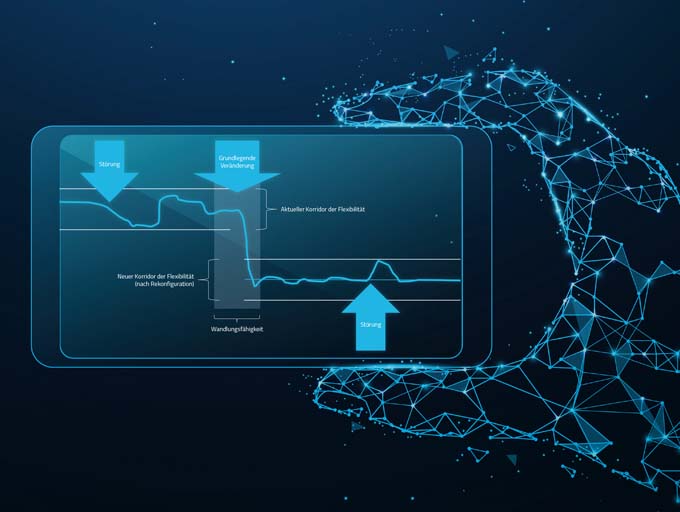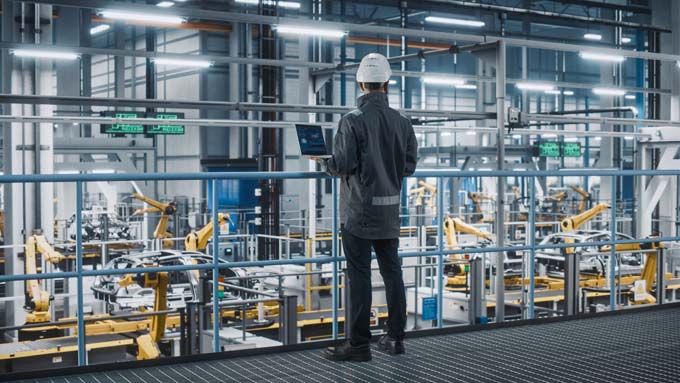Trends in Manufacturing IT 2023: Resilient production
Resilience is a term that is increasingly being mentioned in the context of Industry 4.0. After all, this field of action is an important topic for manufacturing companies, alongside sustainability and interoperability. But what is behind this buzzword and what does it mean for manufacturing IT?

The term resilience is first familiar from the environment of stress management: a resilient person is good at dealing with stress and crises, quickly regaining their equilibrium so they can continue to act and react. Simply put, a resilient person can handle disruption well. But what does the term mean in the context of production processes? And what does it have to do with manufacturing IT?
Resilience and Industry 4.0
Resilience is now also one of the top issues in the Industry 4.0 environment. In a white paper published by the Platform Industry 4.0 defines resilience as follows: "Entrepreneurial resilience is the ability of a company to withstand external shocks or upheavals in the social, economic or political environment and to adapt to new conditions. To this end, the white paper sorts various measures on the one hand into the strategic fields of action of the "Leitbild 2030 der Plattform Industrie 4.0". On the other hand, they are assigned to the three impact phases of preparation, mitigation and adaptation.
So in industry, resilience means that manufacturing companies make preparations to be more resilient. In the event of a disruption, the impact should be as mild as possible. It is also a matter of considering possible adjustments to better deal with changed circumstances. This closes the circle, because the latter adjustments form the starting point for preparing for new disruptions. The distinction according to the strategic fields of action (according to the mission statement 2030 of the Industrie 4.0 platform: sustainability, interoperability and sovereignty) will be discussed again later.
Flexibility and adaptability
To better understand resilience in the Industrie 4.0 environment, it is useful to distinguish between flexibility and adaptability:
- Flexibility means that a company or production can respond to disruptions or requirements at short notice and temporarily. After a certain time, the situation returns to normal.
- Mutability on the other hand, means that production can change to be able to cope with the new conditions in the long term and permanently.
Resilience requires both skills, flexibility and mutability. The methods differ depending on the capability. Therefore, it is important to identify early on how to respond: flexibly or adaptively - i.e., short-term and temporarily or long-term and permanently. Example: A company should react flexibly to the failure of an expected delivery - rather adaptably to the insolvency of an important supplier or the failure of a delivery route.

Excursus: Matrix production
Beyond resilience, matrix production is another Industrie 4.0 trend that has significant implications for manufacturing IT. According to the expertise of the research advisory board of the Industrie 4.0 platform, "Implementation of cyber-physical matrix production systems," such systems are "characterized by a modular structure, flexible control and interlinking of production resources, and a high level of information technology networking." Here, both flexibility and mutability play an essential role, since there are short-term requirements on the one hand and long-term changes in plans on the other. The document also introduces the concept of reconfigurability. This describes the ability of a production system to be reconfigured as required within the change corridor (cf. changeability). In a matrix production, the capabilities that support resilience are used proactively to use the available resources more efficiently. Thus, a matrix production benefits from resilience.
Example: In contrast to a production line, changes can be deliberately brought about in matrix production in order to manufacture other products or products in other batch sizes at short notice - either temporarily or permanently.
Sustainability, interoperability and sovereignty
Resilience builds on the three strategic action areas of sustainability, interoperability, and sovereignty. Sustainability goes far beyond the economical use of resources. Rather, it includes everything that is necessary for production to take place at all. In particular, the role of people as well as education and work organization are of importance here. Interoperability means both the interaction of different (IT) systems and standardization along supply chains. And Sovereignty includes not only security of supply, but also IT security issues and the development of new technologies. Even though these are all big words, there are many starting points for manufacturing IT. Concrete examples illustrate this.
Examples of manufacturing IT in the sustainability field of action:
- The energy management of production IT records consumption of all kinds and makes energy consumption plannable. As a result, external disruptions can be translated more quickly into changes to plans. In addition, targeted savings measures ensure that cost increases have as little impact as possible on production costs.
- Worker management as part of assembly processes ensures that even unskilled employees are quickly trained. This in turn is a good measure to counteract the shortage of skilled workers. On the assembly process modeling side, low-code and no-code ensure that fewer programmers are needed, which are also in short supply on the labor market.
- By means of qualification-based workforce scheduling, human capital is optimally utilized. At the same time, employees' skills can be tested and promoted on a time-controlled basis.
Examples of manufacturing IT in the field of action Interoperability:
- Based on open platform approaches, applications from different providers can be easily combined with each other. This creates a living ecosystem and significantly reduces dependence on individual providers. MPDV Mikrolab GmbH has developed the Manufacturing Integration Platform (MIP) for this purpose. More than 50 providers have already developed so-called mApps for the MIP, which can be combined with each other as desired.
- Manufacturing IT functions for material and inventory management ensure that it is always known when which material is needed and whether sufficient material is available in production or in the warehouse. This makes it easier to deal with disruptions in the supply chain.
Examples of manufacturing IT in the sovereignty action area:
- By using modern technologies such as artificial intelligence, manufacturing IT gets the most out of its own data. This enables manufacturing companies to identify deviations earlier and react to them more quickly.
- If quality assurance is also integrated into the production IT system, a holistic supplier evaluation can be carried out thanks to the comprehensive use of quality data. The aim here is to be able to compensate for any disruptions in the supply chains with alternative procurement options.
Manufacturing IT: Equipped for the future
Ultimately, resilience is based on the sum of many measures and methods for preparation, mitigation and adaptation. At the same time, a broad spectrum of fields of action has an influence on the resilience of production. From a distance, it doesn't look like manufacturing IT plays an important role. But the opposite is the case: manufacturing IT has a small impact, but in total it has a large impact on the whole. Depending on the company, different use cases are more or less relevant.
Author:
Markus Diesner is Senior Marketing Specialist Products at MPDV. You can find another article by this author here.









